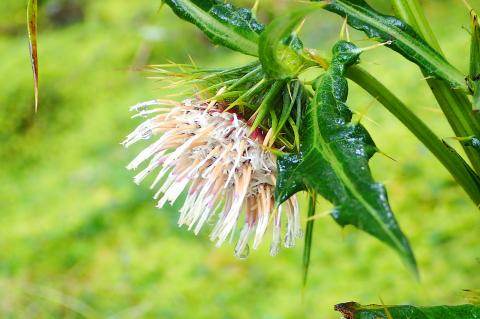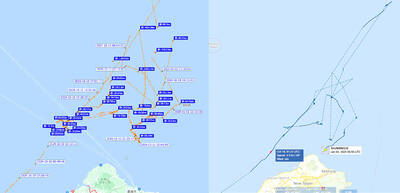A flower species depicted on the NT$1,000 banknote that is commonly believed to be a Yushan thistle is actually a newly discovered species of Cirsium, academics said on Saturday.
Chang Chih-yi (張之毅), a doctoral candidate at National Chung Hsing University’s forestry department, said that the flower is a Cirsium tatakaense — a species endemic to south-central Taiwan that he and his team discovered.
Chang and his supervisor, associate professor Tseng Yen-hsueh (曾彥學), published their findings after five years of research in the international academic journal PhytoKeys on Feb. 14.

Photo courtesy of National Chung Hsing University
The Cirsium tatakaense, which grows in the Tataka area (塔塔加) in Yushan National Park and is often photographed by visitors, can easily be mistaken for the similar-looking Yushan thistle, the two men said.
The flower has yet to be seen outside of the park at altitudes of 2,000m to 3,000m above sea level, they said.
The best place to see the flower is in open areas along the roads near the Tataka Visitor Center, they said, adding that it is in season from August to October.

Photo courtesy of National Chung Hsing University
The flower’s leaves are more slender than those of the Yushan thistle and it has more petals, they said.
The Cirsium tatakaense has a thornier and longer stem, which is easily distinguishable from that of the Yushan thistle, and its petals are white, droop when in bloom and have sharp toothpick-like thorns surrounding their base, they said.
The researchers also examined pollen samples from the two plants and found that the Cirsium tatakaense has much larger grains of pollen.
Although the number of Cirsium tatakaense is low, there is little danger of the plant becoming extinct, as the remoteness and high elevation of its habitat means it is protected from human activity, Chang and Tseng said.
However, climate change could affect the flower’s growth, so efforts should be made to conserve the plant, the academics said.

DEEPER REVIEW: After receiving 19 hospital reports of suspected food poisoning, the Taipei Department of Health applied for an epidemiological investigation A buffet restaurant in Taipei’s Xinyi District (信義) is to be fined NT$3 million (US$91,233) after it remained opened despite an order to suspend operations following reports that 32 people had been treated for suspected food poisoning, the Taipei Department of Health said yesterday. The health department said it on Tuesday received reports from hospitals of people who had suspected food poisoning symptoms, including nausea, vomiting, stomach pain and diarrhea, after they ate at an INPARADISE (饗饗) branch in Breeze Xinyi on Sunday and Monday. As more than six people who ate at the restaurant sought medical treatment, the department ordered the

A strong continental cold air mass and abundant moisture bringing snow to mountains 3,000m and higher over the past few days are a reminder that more than 60 years ago Taiwan had an outdoor ski resort that gradually disappeared in part due to climate change. On Oct. 24, 2021, the National Development Council posted a series of photographs on Facebook recounting the days when Taiwan had a ski resort on Hehuanshan (合歡山) in Nantou County. More than 60 years ago, when developing a branch of the Central Cross-Island Highway, the government discovered that Hehuanshan, with an elevation of more than 3,100m,

Taiwan’s population last year shrank further and births continued to decline to a yearly low, the Ministry of the Interior announced today. The ministry published the 2024 population demographics statistics, highlighting record lows in births and bringing attention to Taiwan’s aging population. The nation’s population last year stood at 23,400,220, a decrease of 20,222 individuals compared to 2023. Last year, there were 134,856 births, representing a crude birth rate of 5.76 per 1,000 people, a slight decline from 2023’s 135,571 births and 5.81 crude birth rate. This decrease of 715 births resulted in a new record low per the ministry’s data. Since 2016, which saw

SECURITY: To protect the nation’s Internet cables, the navy should use buoys marking waters within 50m of them as a restricted zone, a former navy squadron commander said A Chinese cargo ship repeatedly intruded into Taiwan’s contiguous and sovereign waters for three months before allegedly damaging an undersea Internet cable off Kaohsiung, a Liberty Times (sister paper of the Taipei Times) investigation revealed. Using publicly available information, the Liberty Times was able to reconstruct the Shunxing-39’s movements near Taiwan since Double Ten National Day last year. Taiwanese officials did not respond to the freighter’s intrusions until Friday last week, when the ship, registered in Cameroon and Tanzania, turned off its automatic identification system shortly before damage was inflicted to a key cable linking Taiwan to the rest of